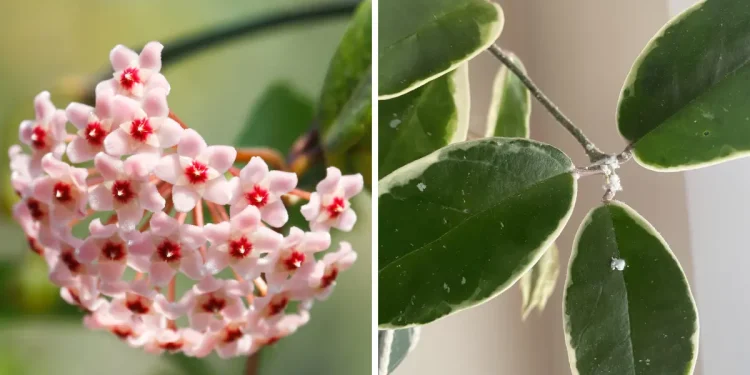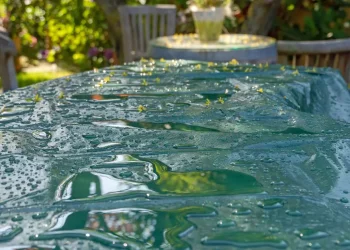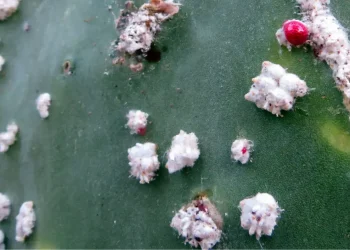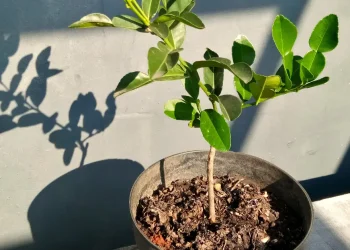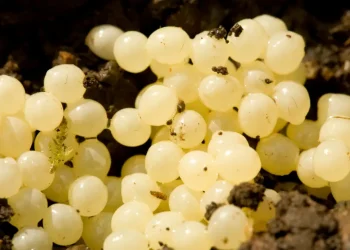Hoyas may not be the easiest indoor plant to care for, but they make up for it with their beautiful flowers. However, the flowers are not the only thing that needs your attention.
Sometimes, hoya leaves can develop white spots that can indicate various issues or white fungus called powdery mildew. While mild infestations may not harm your plant significantly, severe cases can weaken it, which can only accumulate more issues.
In this article, we’ll take a look at the most common causes of white spots on hoya leaves and how to deal with them. Don’t worry, in most cases, we’ll do just fine without any chemical fungicides.
What Causes White Spots on Hoya Leaves?
There are several factors that can lead to the appearance of these white spots on your hoya plant’s leaves. They each have slightly different characteristics. For instance, a common cause is pest infestation, where a bug called mealybug creates a silky smooth white coating on the leaves.
In this part, I’ll cover all the most common causes of white spots on hoya leaves and how to deal with them.
1. Fungal Infections
Fungal infections can be a primary reason for the emergence of white spots on hoya leaves. These infections are often the result of high humidity levels, poor air circulation, or overly damp conditions, creating an inviting environment for fungal spores to thrive.
The most common fungal disease you may encounter on hoyas is powdery mildew.
Powdery mildew manifests as a white, powdery substance on the leaves, resembling a dusting of flour. It typically makes its way to your hoya plant through airborne fungal spores. Your plant will definitely catch some spores during its lifetime, so the most important thing here is prevention – that’s not giving fungi the opportunity to reproduce.
Powdery mildew isn’t that dangerous per se. However, it can obstruct the leaves, reducing their ability to capture sunlight and perform photosynthesis effectively, which can ultimately lead to leaf drop.
How to Treat Fungal Infections and Powdery Mildew
When dealing with fungal infections on your hoya plants, prompt action is key to restoring your plant’s health.
Begin by isolating the affected plant to prevent the spread of spores to nearby plants. Fungi are not very picky and will breed on whatever is suitable. Trust me that you don’t want to deal with multiple plants infected at once. So quarantine the infected plant immediately.
Gently prune and remove the heavily infected leaves. This gives the plant room to focus on healthier leaves and improves its overall health.
Next, improve the growing conditions by increasing ventilation, reducing humidity, and avoiding overhead watering – avoid getting water on the leaves!
When nothing seems to work, and the health of your plant has not improved after a week, consider applying a fungicide. In this case, more is not better, and you should always follow the manufacturer’s instructions. Neem oil or other natural fungicides can also be effective, at least for milder infestations.
As I’ll tell you later on, prevention is key, so don’t sleep on your plant’s health.
2. Pests and Insects
Another common cause of those white spots on hoya leaves is the unwelcome presence of pests and insects.
Aphids, mealybugs, and other insects are especially attracted to hoyas because their foliage is rich in sap, which they feed on.
Among the culprits, the mealybug takes center stage as a frequent antagonist. As they feed on the sap, they leave a sticky, sugary residue known as honeydew behind. This white substance can attract ants or encourage the growth of mold.
How to Deal with Pest Infestation
I always encourage reaching for an insecticide as soon as possible. These little bugs reproduce like crazy and can very easily infect your other plants too.
You can try and use a natural pest solution like neem oil solution or soapy water, but they are usually not as effective. But it may work just fine for small infestations.
In my opinion, it is much better for the plant to use a chemical insecticide, which although not the most gentle solution, is better than weeks of ineffective pest treatment.
3. Environmental Stress
Environmental stress factors can also play a role in the development of white discoloration on hoya leaves. These stressors may include excessive humidity, poor air circulation, and inadequate lighting conditions.
High humidity without proper ventilation can create an environment conducive to fungal growth. Similarly, insufficient light or overcrowding can stress the plant, causing it to allocate resources inadequately, which may result in discoloration or white markings on the leaves.
To mitigate these environmental stressors, ensure that your hoya is grown in conditions that mimic its natural habitat, with proper humidity levels, good airflow, and adequate lighting. Wax plants are native to various tropical and subtropical regions of Asia and Australia. Its native habitat includes high humidity levels, good air circulation, and multiple hours of filtered sunlight through the canopy of trees.
4. Mineral Deposits
There are so many possible causes that even watering with hard water can cause white spots on hoya leaves.
When hard water with a high mineral content, such as calcium or magnesium, is used for irrigation or misting, these minerals can accumulate over time.
As the water slowly evaporates on the leaves’ surface, it leaves behind any dissolved minerals. Those minerals can build over time, forming a white, chalky coating.
This coating can once again suppress leaves’ ability to absorb light and perform photosynthesis effectively.
How to Deal with Mineral Deposits on Leaves
Sometimes, mineral deposits are inevitable, and the best thing you can do once it build up on the surface of the leaves is to wipe it down. I periodically wipe down the leaves of all my plants because not only minerals can build up, but also dust, which also obstructs the way of light. You can use the recipe for my DIY leaf shine from the article about How to clean leaves and make them shine again.
Another thing to consider is using water that is not that heavy in minerals for watering. This means distilled or rainwater. Alternatively, you can get a cheap water filter and let the water go through that.
5. Natural Coloring
Lastly, let’s not forget that sometimes it’s not as bad as it may seem. A hoya plant is a living organism that, as it grows, can get different mutations or characteristics that can create random patches, stripes, or streaks of discoloration.
So, if you notice some subtle differences in leaf coloration, it might simply be a reflection of your hoya’s individuality and genetic makeup rather than a cause for concern.
There are a few things you should look for when observing what the cause is.
Natural coloring tends to be consistent and uniform across the affected leaves or areas. If the variation in color appears evenly distributed and doesn’t change over time, it’s more likely to be a natural trait.
Also, natural coloring usually develops gradually as the plant grows and matures. Sudden and dramatic changes in leaf coloration are more likely to be signs of stress or disease.
Prevention is Key
When it comes to the well-being of your hoya plant and preventing issues like white spots on its leaves, proactive care is your greatest ally.
Creating an environment that mimics its natural habitat or at least an environment that is uninviting to pests and diseases is crucial. For this, lighting conditions, humidity levels, proper air circulation, and all the other things like watering and nutrients need to be on the spot.
Start by choosing the right spot to place your hoya in. The pot should be placed somewhere where the plant will be able to get indirect light all day long. Some do well with about two hours of direct sunlight in the morning, but be careful because too much direct sun can burn the leaves.
The spot should also introduce good airflow. Placing the pot right next to a wall may not be the best idea.
Hoyas don’t like being constantly wet. Make sure the soil is completely dried before watering it again. Watering your hoya once every 14 days is just about right. This especially helps against fungi or pests.
And if, despite your best efforts, some issues emerge, take swift and appropriate action.
Before you go…
You got hoya for their beautiful flowers, right? Then preventing those annoying white spots on hoya leaves is just the first step. Read my next article to ensure that those flowers last as long as possible…

